David Eagleman is the host of The Brain on PBS, as well as the author of the book of the same name. In this video, he tackles several fascinating subjects concerning your brain. If the brain is merely the hardware, could we emulate its software somewhere else? Could we simulate your version of consciousness on a man-made computer? Yes, says Eagleman, although it’s not going to happen anytime soon. But when it does, and we’re able to move beyond our flesh, deep space travel goes from being impossible to possible.
David Eagleman: The big picture in modern neuroscience is that you are the sum total of all the pieces and parts of your brain. It’s a vastly complicated network of neurons, almost 100 billion neurons, each of which has 10,000 connections to its neighbors. So we’re talking a thousand trillion neurons. It’s a system of such complexity that it bankrupts our language. But, fundamentally it’s only three pounds and we’ve got it cornered and it’s right there and it’s a physical system.
The computational hypothesis of brain function suggests that the physical wetware isn’t the stuff that matters. It’s what are the algorithms that are running on top of the wetware. In other words: What is the brain actually doing? What’s it implementing software-wise that matters? Hypothetically we should be able to take the physical stuff of the brain and reproduce what it’s doing. In other words, reproduce its software on other substrates. So we could take your brain and reproduce it out of beer cans and tennis balls and it would still run just fine. And if we said hey, "How are you feeling in there?" This beer can/tennis ball machine would say "Oh, I’m feeling fine. It’s a little cold, whatever."
It’s also hypothetically a possibility that we could copy your brain and reproduce it in silica, which means on a computer at zeroes and ones, actually run the simulation of your brain. The challenges of reproducing a brain can’t be underestimated. It would take something like a zettabyte of computational capacity to run a simulation of a human brain. And that is the entire computational capacity of our planet right now.
There’s a lot of debate about whether we’ll get to a simulation of the human brain in 50 years or 500 years, but those would probably be the bounds. It’s going to happen somewhere in there. It opens up the whole universe for us because, you know, these meat puppets that we come to the table with aren’t any good for interstellar travel. But if we could, you know, put you on a flash drive or whatever the equivalent of that is a century from now and launch you into outer space and your consciousness could be there, that could get us to other solar systems and other galaxies. We will really be entering an era of post-humanism or trans-humanism at that point.
Now because it seems like a possibility that we could download and simulate — not in our lifetimes, but soon — that has opened up a question from many people, which is how would we know if we’re already living in a simulation? Maybe we are the products of a civilization that came a billion years before us and we’re already living in The Matrix. And this is a position that philosophers are taking seriously.
In fact, Rene Descartes, the French philosopher, had a version of this when he asked how would I know if I’m just a brain in a vat and I’m being stimulated by scientists to make me think that I’m hearing, and seeing, and feeling and so on. And his conclusion, like others that have followed him, is that you actually can’t know. Really it would be almost impossible to know because all of this feels real to you. And so Descartes’ solution to this was to say you know, I might not ever be able to really know, but there’s somebody who’s asking the question and therefore I exist. There’s some "I" at the center of all this that’s thinking about this. And so that was a solution for him but it doesn’t solve the bigger question of how would we know if we’re already in the simulation and we may well be.





